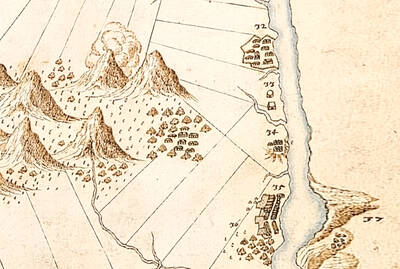After celebrating the Ritual of the Short Black People (矮靈祭) we collected the next morning in the sunlight on a porch overlooking the dappled mountains of Wufeng Township in Hsinchu. Saisiyat tribe elder Amin (Lin Zhen-ming,
The amiable 55-year-old did not know how long it had been since the last black pygmy lived in one of those caves, but there are records of these original Taiwanese people in Qing dynasty (1644 to 1911) documents. Some gathered on the porch said the ritual commemorating the Short Black People had been going on for 400 years, since the Aboriginal Saisiyat are said to have wiped them out. Another tribal elder suggested the extinction was later, some time in the last century.

PHOTOS: JULES QUARTLY, TAIPEI TIMES
Amin was like a big brother to everyone, an electrician/plumber/fix-it man and just the kind of person you could turn to when your battery was bled to death by sleeping in an air-conditioned car without the engine on. He said life in the city was exciting and he would do jobs there, but he was always glad to come home because friends and family meant more to him than money. "Here," he said, surveying the land, a Middle-Earth-like vision of lush mountains and smoke trailing out of nearby settlements. "It's pure."

Amin said he was aware of and generally agreed with a study backed by the Saisiyat tribe that established the Short Black People as racially similar to groups now living in Malaysia and the Philippines. He said they were described in stories passed down by his parents as having red hair like these people. He said they were short, but not little, as they were strong.
The race is said by various out-of-Africa theorists to have arrived in Asia as long as 20,000 to 50,000 years ago. The first mythical emperor, Fu Hsi (伏羲) was a "black dwarf," they claim. Aborigines are thought to have migrated to Taiwan about 3,000 years ago (other estimates range from 1,000 to 10,000 years). There is another theory that Taiwanese tribes were the first Austronesians.
Though the origins of
civilization in Taiwan are hotly debated, everyone seems to agree the end of the black pygmies came at the hands of the Saisiyat. The oral history has been passed on over generations by the Saisiyat, in the 16 songs and in the Ritual of the Short Black People held every two years in Nanchuang Township, Miaoli County and Wufeng. There are similar published versions, Amin acknowledged, but this was his story.
Amin said the God of the Short Black People that is prayed to at the rituals represents an advanced race that was kind, gentle and helpful but was also puckish or worse. It was because of this nature that the last of the Short Black People got into trouble with the Saisiyat. The black pygmies liked to flirt with the Saisiyat women but they went too far when they sexually molested an Aboriginal princess and her handmaidens. The Saisiyat men were angry, so they plotted their revenge and invited the pygmies to a harvest festival. On leaving the party the pygmies crossed a bridge.
It was here, Amin said, waving in the general direction of the caves below the porch on which we were sitting, where the pygmies died. He pointed to the far side of the river and described a bridge with his hands. Then he made a cutting motion to describe how the bridge was cut. The pygmies fell to their deaths and only one escaped. He taught the Saisiyat knowledge that had been handed down and before disappearing at dawn, into the sunrise, he warned them: if his race's legends died out, then so would the Saisiyat. Amin further explained there was a small population of black pygmies before this incident and they did not have many women, so perhaps this is why they raped the Saisiyat women.
Currently, there are fewer than 5,000 Saisiyat among a population of under 400,000 Indigenous or Aboriginal people in Taiwan. Many Saisiyat marry into other tribes or Han families, so numbers are decreasing. Amin's mother is Saisiyat but his father is Atayal. The tribe is usually but not necessarily patri-lineal. Amin described himself as part of the Lin (林) family or clan that is part of the Saisiyat tribe.
As for the caves below, where the black pygmies were said to live, we were asked to stay away. Amin said the cliffs to get there were too steep. He said those who had photographed the place had their film cleared. There were even curses of the Short Black People that involved memory loss and confusion for those foolhardy enough not to heed the warnings. As it happened, some photos I had taken the previous night had mysteriously disappeared and the car wouldn't start, so the trip was a non-starter.
Amin and the Saisiyat guard the caves, hold the rituals and tell the stories that keep alive the legacy of Taiwan's original settlers, now that they are gone.

Last week gave us the droll little comedy of People’s Republic of China’s (PRC) consul general in Osaka posting a threat on X in response to Japanese Prime Minister Sanae Takaichi saying to the Diet that a Chinese attack on Taiwan may be an “existential threat” to Japan. That would allow Japanese Self Defence Forces to respond militarily. The PRC representative then said that if a “filthy neck sticks itself in uninvited, we will cut it off without a moment’s hesitation. Are you prepared for that?” This was widely, and probably deliberately, construed as a threat to behead Takaichi, though it

Nov. 17 to Nov. 23 When Kanori Ino surveyed Taipei’s Indigenous settlements in 1896, he found a culture that was fading. Although there was still a “clear line of distinction” between the Ketagalan people and the neighboring Han settlers that had been arriving over the previous 200 years, the former had largely adopted the customs and language of the latter. “Fortunately, some elders still remember their past customs and language. But if we do not hurry and record them now, future researchers will have nothing left but to weep amid the ruins of Indigenous settlements,” he wrote in the Journal of

Even after years in business, weekend tables here can be booked out a month in advance. The price point far exceeds its competitors. Granted, expectations are soaringly high, but something here failed to hit the high notes. There are a few telltale signs that a restaurant relies solely on outstanding food to create the experience, no gimmicks or distractions needed. La Mole is such a restaurant. The atmosphere is food-forward, with an open kitchen center stage. Our tables are simple; no candles, no dim lighting, no ambient music. The menu is brief, and our waiter directs most

If China attacks, will Taiwanese be willing to fight? Analysts of certain types obsess over questions like this, especially military analysts and those with an ax to grind as to whether Taiwan is worth defending, or should be cut loose to appease Beijing. Fellow columnist Michael Turton in “Notes from Central Taiwan: Willing to fight for the homeland” (Nov. 6, page 12) provides a superb analysis of this topic, how it is used and manipulated to political ends and what the underlying data shows. The problem is that most analysis is centered around polling data, which as Turton observes, “many of these